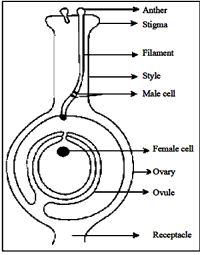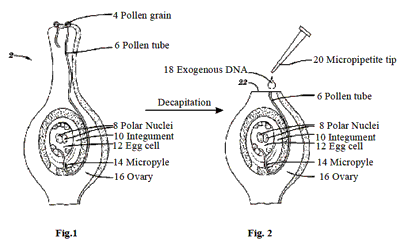(HOT) UPSC Current Affairs 2025 PDF
NEW! The Gist (NOV-2025) | E-BOOKS
(IGP) IAS Pre: GS - Science & Technology : Botany - Plant Reproductive System
Botany
Plant Reproductive System
INTRODUCTION
Animal life cycles have meiosis followed immediately by gametogenesis. Gametes are produced directly by meiosis. Male gametes are sperm. Female gametes are eggs or ova. The plant life cycle has mitosis occurring in spores, produced by meiosis, that germinate into the gametophyte hase. Gametophyte size ranges from three cells (in pollen) to several million (in a “lower plant” such as moss). Alternation of generations occurs in plants, where the sporophyte phase is succeeded by the gametophyte phase. The sporophyte phase produces spores by meiosis within a sporangium. The gametophyte phase produces gametes bymitosis within an antheridium(producing sperm) and or archegonia (producing eggs). Within the plant kingdom the dominance of phases varies. Nonvascular plants, the mosses and liverworts, have the gametophyte phase dominant. Vascular plants show a progression of increasing sporophyte dominance from the ferns and “fern allies” to angiosperms.
FLOWERING PLANTS
Flowering plants, the angiosperms, were the last of the seed plant groups to evolve, appearing over 100million years ago during themiddle of theAge ofDinosaurs (late Jurassic). All flowering plants produce flowers and if they are sexually reproductive, they produce a diploid zygote and triploid endosperm.
FLOWERS
Flowers are collections of reproductive and sterile tissue arranged in a tight whorled array having very short internodes. Sterile parts of flowers are the sepals and petals. When these are similar in size and shape, they are termed tepals.Reproductive parts of the flower are the stamen (male, collectively termed the androecium) and carpel (often the carpel is referred to as the pistil, the female parts collectively termed the gynoecium).
STAMENS
The individual units of the androeciumare the stamens, which consist of a filament which supports the anther. The anther contains four microsporangia within which microspores (pollen) are produced by meiosis. Stamens are thought to represent modified sporophylls (leaves with sporangia on their upper surface

POLLEN
Pollen grains (fromthe greek palynos for dust or pollen) contain the male gametophyte (microgametophyte)phase of the plant. Pollen grains are produced by meiosis of microsporemother cells that are located along the inner edge of the anther sacs (microsporangia). The outer part of the pollen is the exine, which is composed of a complex polysaccharide, sporopollenin. Inside the pollen are two (or, at most, three) cells that comprise the male gametophyte. The tube cell (also referred to as the tube nucleus) develops into the pollen tube. The germ cell divides by mitosis to produce two spermcells. Division of the germcell can occur before or after pollination.
POLLINATION
The transfer of pollen from the anther to the female stigma is termed pollination. This is accomplished by a variety of methods. Entomo-phyly is the transfer of pollen by an insect. Anemophyly is the transfer of pollen by wind. Other pollinators include birds, bats, water, and humans. Some flowers (for example garden peas) develop in such a way as to pollinate themselves. Others have mechanisms to ensure pollination with another flower. Flower color is thought to indicate the nature of pollinator: red petals are thought to attract birds, yellow for bees, and white for moths. Wind pollinated flowers have reduced petals, suchas oaks and grasses.
GYNOECIUM
The gynoeciumconsists of the stigma, style, and ovary containing one or more ovules. These three structures are often termed a pistil or carpel. In many plants, the pistils will fuse for all or part of their length.
THE STIGMA AND STYLE
The stigma functions as a receptive surface on which pollen lands and germinates its pollen tube. Corn silk is part stigma, part style. The style serves to move the stigma some distance from the ovary. This distance is species specific.
THE OVARY
The ovary contains one or more ovules, which in turn contain one female gametophyte, also referred to in angiosperms as the embryo sac. Some plants, such as cherry, have only a single ovary which produces two ovules. Only one ovule will develop into a seed.
THE GAMETOPHYTES
Themale gametophyte develops inside the pollen grain. The female gametophyte develops inside the ovule. In flowering plants, gametophyte phases are reduced to a few cells dependant for their nutrition on the sporophyte phase. This is the reverse of the pattern seen in the nonvascular plant groups liverworts, mosses, and hornworts (the Bryophyta). Angiosperm male gametophytes have two haploid nuclei (the germnucleus and tube nucleus) contained within the exine of the pollen grain (or microspore). Female gametophytes of flowering plants develop within the ovule (megaspore) contained within an ovary at the base of the pistil of the flower. There are usually eight (haploid) cells in the female gametophyte: a) one egg, two synergids flanking the egg (located at the micropyle end of the embryo sac) b) two polar nuclei in the center of the embryo sac; and three antipodal cells (at the opposite end of the embryo sac from the egg).
DOUBLE FERTILIZATION
The process of pollination being accomplished, thepollen tube grows through the stigma and style toward the ovules in the ovary. The germcell in the pollen grain divides and releases two sperm cells which move down the pollen tube. Once the tip of the tube reaches the micropyle end of the embryo sac, the tube grows through into the embryo sac through one of the synergids which flank the egg. One sperm cell fuses with the egg, producing the zygote whichwill later develope into the next-generation sporophyte. The second sperm fuses with the two polar bodies located in the center of the sac, producing the nutritive triploid endosperm tissue that will provide energy for the embryo’s growth and development. FRUIT The ovary wall, after fertilization has occurred, develops into a fruit. Fruits may be fleshy, hard, multiple or single. Note:- View the Seeds of Life site for illustrations and information about fruits and seeds. Seeds germinate, and the embryo grows into thenext generation sporophyte.
VEGETATIVE PROPAGATION
Many plants also have an asexual method of reproduction. Often some species, such as many orchids, are more frequently propagated vegetative than via seeds. Tubers are fleshy underground stems, as in the Irish potato. Leaflets are sections of leaf will develop roots and drop off the plant, effectively cloning the plant. Runners are shoots running along or over the surface of the ground that will sprout a plantlet, which upon settling to the ground develop into a new independent

FACTS FROM NCERT
- Flowers are the reproductive parts of a plant.
- In asexual reproduction plants can give rise to new plants without seeds.
- In sexual reproduction, new plants are obtained from seeds.
- In asexual reproduction the reproduction is happen through the negative parts of the plant, it is known as negative propagation.
- Yeast reproduces through budding.
- Algae grow andmultiply rapidly by fragmentation. An algae break up into two or more fragments. These fragments or pieces grow into new individuals.
- Fungi on bread pieces grow from spores which are present in the air, spores are asexual reproductive bodies
- Under favourable condition a spore germinates and develops into a new individual.
- Plants such as mass and farness also reproduce by means of spores.
- In sexual reproduction the stamens are the male reproductive part. The pistil is the female reproduction part.
- The flowers which contain either only the pistil or only the stamens are called unisexual flowers
- The flowers which both stamens and pistil are called bisexual flowers.
- Corn, papaya and cucumber produce unisexual flowers.
- Spores are covered by a hard protective coat to with stand unfavorable conditions such as high temperature and low humidity.
- Mustard, rose and petunia have bisexual flowers.
- Another contains pollen grains which produce male gametes.
- The female gamete or the egg is formed in an ovule.
- The transfer of pollen fromthe other to the stigma of a flower is called pollination.
- When the pollen of a flower lands on the stigma of another flower of the same plant or that of a different plant of the same kind is called crosspollination.
- After fertilization the ovary grows into a fruit, the fruit is the ripened ovary.
Click Here to Download full Chapter
Click Here for Plant Reproductive System MCQ
© UPSCPORTAL.COM


